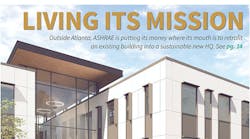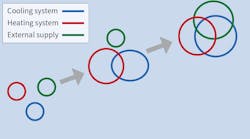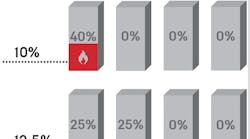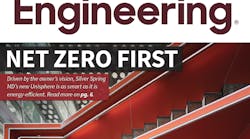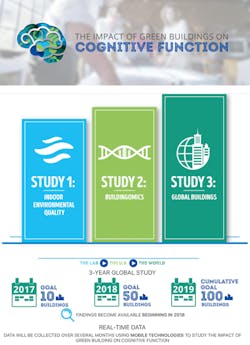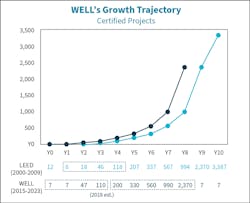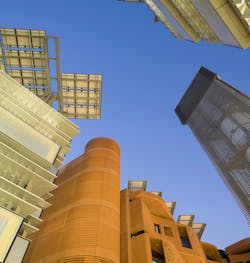By Dan Diehl
Aircuity
Newton MA
Only a few short years ago, owners and the design community were focused on experience-centered designs, with a foundation around grand lobbies, fancier materials and lighting for aesthetic features. The consideration for the occupant was about the experience and visual impact. However, the amount of high-profile research completed in the last few years along with new building standards is moving the focus towards the occupant’s overall health & productivity. The benefits of this design are now being accepted as undeniable and providing the largest impact for owners and developers alike.
The Evidence
The COGfx Study I, that was led by the Harvard T.H. Chan School of Public Health’s Center for Health and Global Environment, was published in late 2015 and was the first study to seemingly grab industry acceptance. Researchers evaluated the cognitive performance of 24 participants who experienced conditions in a laboratory setting that simulated those found in conventional and green buildings, as well as green buildings with enhanced ventilation. It found that employees’ cognitive performance scores averaged 101 percent higher in green building environments with enhanced ventilation. Essentially, workers thought twice as clearly with better air. The COGfx Study II followed shortly after and showed the positive effects of a high performing green certified building versus those not certified. Occupants in certified buildings performed 73% better when in a ‘crisis’ situation. The third COGfx Study is currently underway and takes the study to a global level.
In 2016, Jones Lang LaSalle came out with its 3/30/300 rule; which provides more evidence about just how important it is to design an optimal environment for the occupant. JLL’s example analyzed total owner building/site spending per square foot. It found that owners typically attribute $3 for utilities, $30 for rent, and $300 for payroll. Further analysis, and some simple math, shows that a 10% increase in energy efficiency yields a $0.30 savings per square foot, while a 10% decrease in rent will save $3.00. Alarming, but true, is that a 10% gain in productivity is worth $30, thus demonstrating that a 1% improvement on productivity is worth the entire energy budget.
Energy efficiency is critically important and shouldn’t be abandoned for obvious reasons. However, this does highlight that even a small improvement is well worth the focus of all tiers of the chain — owners, architects, developers, and even contractors. Subpar systems design and implementation through data and analytics will very soon no longer be valued or tolerated. Value engineering will be what it was intended to be — adding value to the project and not stripping it away.
A New Frontier of Standards
The growth of standards such as RESET and the International WELL Building Institute’s WELL Building Standard that focus on the health of the occupant are a sharp reflection of the adoption of a new occupant-focused mindset. In fact, the WELL Building Standard’s growth is on par with LEED during its early years. These standards first saw growth in places such as Beijing where the air quality is typically worse outdoors than inside. The WHO reported that in 2012 the Western Pacific Region saw 2.8 million deaths caused by air pollution.
Now other regions including the US are seeing a growing adoption of these healthy building certification programs. As of August 2019, IWBI reported over 390 million square feet of WELL-Certified space across five countries.
If the amount of certified space doesn’t tell the story, case studies surely do. After CBRE Canada’s office space became WELL-Certified, employee turnover dropped by 1/3 and the hiring rate for new talent has doubled. Meanwhile the US Green Building Council completed a study at the WELL-Certified Cundall Office in the UK and found that improved indoor environmental quality saved the company £200,000 through a reduction in sick days.
Importance of Air
One common thread throughout the research and healthy building standards is the importance of air for human health. As humans we inhale 15,000 liters of air a day and we spend 90% of our times indoors; which means a healthy and productive space should have the proper ventilation in place.
Typically, building design calls for Demand Control Ventilation (DCV) and does so by code in certain populated areas. However, this is not typically implemented effectively because of the ‘weakest link’ in the chain – discrete sensors. As most owners who operate and maintain their buildings know, discrete sensors don’t work unless properly maintained and this rarely if ever happens. The previously discussed studies also highlight that just monitoring and controlling based on CO2 isn’t enough. Often particles and total volatile organic compounds (TVOCs) are more critical to control for health and overall well-being.
The Good News
For the last decade there has been a growing movement in critical environments (labs) and now non-critical environments (commercial offices) around multi-parameter demand control ventilation (MpDCV). Technology now affords a positive net present value alternative that utilizes a centralized set of sensors to optimize a building’s ventilation based on a variety of parameters.
Influenced by WELL and the stated research, many owners are designing around a 60% increase in outside air. At first glance it may seem as though this is a huge energy cost and in conflict to required efficiency and sustainability goals. But to the contrary this is when properly implemented DCV is needed most. Rather than just pumping more air in to meet the need for better ventilation, which increases costs, an MpDCV platform provides the right amount of fresh air when needed and turns down ventilation when the air is “clean”.
Office buildings, labs, libraries, teaching buildings and conference rooms aren’t full all day every day. MpDCV can create better environments, where and when needed that provide efficiency, health and enhanced productivity.
Thus, MpDCV helps building owners to address their largest expense – the $300 focus. Employees can now feel healthier and have improved cognitive performance via improved smart ventilation and at a better life cycle cost.
Design and Implementation
As the future moves to healthier and more productive environments, it will also move toward a merger of data sets and continued validation of these concepts for employers, developers and even the contracting community. Many owners already won’t implement another strategy after years of failed designs and implementations and sub-par building performance. Making buildings really work is only possible with a good chain from design to implementation.
All of us in the industry make fun of the value engineering process where smart design gets replaced with cheap and short-term solutions. Yet the same group of us allow the madness to continue. These short-term solutions are commonly retrofitted just years later, creating double or triple the ‘waste’ in dollars with rework and negative impact on occupants.
The solution isn’t that complicated but it is still hard to implement in our challenged industry. Our recommended solution is a very simple three-step process: 1) Start with designing to occupant; 2) Create a unified team around your business mission placing correct value on their scoring decision matrix, and; 3) Allow the team to complete project based on these priorities.
Building owners will know, as the occupants are not shy about sharing their feedback, positive or negative. Follow-through on the results will provide the feedback loop needed for further adoption. (No surprise that often negative results and feedback don’t get the attention they deserve.)
A facility focused around the occupant will turn a building into a strategic asset that helps further mission critical objectives of the occupant. It is that simple, whether in a learning and teaching environment, research space, operating room, or commercial work setting. This is an ‘ideal that can be put into practice more universally and it will be good for all of us, as well as the environment. It is a worthy pursuit.
